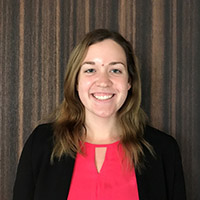By Jessica Deters
Margot Lee Shetterly, author of Hidden Figures, and Dr. Christine Darden, a retired NASA human computer and aeronautical engineer, were met by a crowd so large that there can be little debate that their panel discussion was a must-attend event at the Joint Mathematics Meetings in Atlanta on January 4. With nearly 200 seats full and the margins of the room filled with eager mathematicians, not even breaking down the divider to add an equally-sized room could quell the standing crowd.
Katherine Johnson receiving the Presidential Medal of Freedom in 2015. Photo credit: Wikimedia Commons
“It felt more like a rock concert than a math conference,” Darden remarked afterward. Which is more than appropriate for the event celebrating the black female mathematicians at NASA—Dorothy Vaughan, Mary Jackson and Katherine Johnson—who ensured the United States’ victory in the Space Race. Darden began working as a human computer in the 1960s, about 25 years after the movie adaptation of the book is set, but stars in the book alongside Vaughan, Jackson and Johnson.
Shetterly, who can be credited with revealing these hidden figures to the world, hopes that the stories and accomplishments of these women will take center stage in the retelling of this historical era. But, she had another goal in mind as well.
“For these women to receive professional recognition – that’s why I wrote this,” Shetterly said. Such a warm welcome from professional mathematicians made this a reality. In addition, Shetterly and Darden were both granted lifetime memberships to the National Association of Mathematics, a professional organization dedicated to promoting excellence in the mathematical sciences as well as development of underrepresented minorities in mathematics, by president Edray Herber Goins at the end of the panel presentation.
From left to right: Dorothy Vaughan, Leslie Hunter, and Vivian Adair: Human Computers working at NACA, later NASA. Photo credit: Wikimedia Commons
While the event, book, and movie warrant the rock-star like response, we must remember their struggles do not exist solely in the past. As one undergraduate student asked, “As a mathematician who is an African American woman, how do I avoid being hidden?” This question forces us to remember that, though this tale deserves its place at the center of history, the greater problem remains. Shutterly immediately handed the microphone to Darden, who encouraged the woman, and all of us, to be assertive. She recalled mentoring an intern at NASA from the same university who had been placed in a laboratory with various machines but no real task. When the intern told Darden she had envisioned more for her summer, Darden told her that the laboratory was located right next to a hallway that housed all of the engineering reports. She encouraged the woman to search through the reports, read the ones that interested her, and then to go to the engineer that wrote it and ask questions. By being assertive and both showing the engineers she understood and was interested in their work, she was able to secure assignments outside of the laboratory. At the end of the summer, Darden recalls a letter from the intern’s mother acknowledging that as the best piece of advice her daughter had received.
Dorothy Vaughan, Mary Jackson and Katherine Johnson lent their shoulders to Christine Darden who lent hers to the next generation and ours. The ladder exists, but we must have the courage to climb.
 |
Jessica Deters is a senior at Colorado School of Mines completing her BS and beginning her MS in Applied Mathematics and Statistics. She's passionate about effective communication of mathematics to the masses and increasing diversity in STEM. |